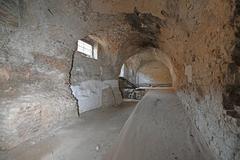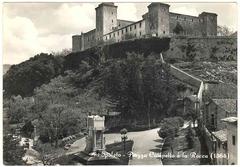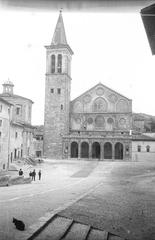
Basilica of San Salvatore Spoleto: Visiting Hours, Tickets, and Travel Guide
Date: 04/07/2025
Introduction
The Basilica of San Salvatore in Spoleto, Italy, stands as a unique testament to early Christian and Lombard architecture. Its origins, dating between the late 4th and early 6th centuries CE, mark a pivotal transition from Roman paganism to Christian worship, as the basilica was constructed atop a former Roman cemetery (Secret Umbria; Umbria Tourism). Recognized in 2011 as part of the UNESCO World Heritage serial site “The Lombards in Italy. Places of Power (568–774 AD),” the basilica embodies centuries of religious, artistic, and cultural evolution (longobardinitalia.it).
This guide offers essential information—visiting hours, ticketing, accessibility, and travel tips—alongside a detailed look at the basilica’s history, architecture, and significance, ensuring you make the most of your visit to this remarkable monument.
Table of Contents
- Historical Background
- Architectural Features
- Artistic and Religious Significance
- UNESCO Recognition and Lombard Heritage
- Practical Visitor Information
- Getting There
- Nearby Attractions and Amenities
- Frequently Asked Questions (FAQ)
- Conclusion and Recommendations
- References
Historical Background
Constructed in the transitional era from late antiquity to the early Middle Ages, the Basilica of San Salvatore is among Umbria’s oldest Christian monuments. Its foundation is generally placed between the late 4th and early 6th centuries CE, though archaeological evidence—including organic remains analyzed from a bowl found during 1966 restorations—suggests active use by at least the mid-6th century (Secret Umbria).
Originally, the church may have been dedicated to Saint Concordius, a local martyr. By the 8th century, following a significant renovation, it became known as San Salvatore, reflecting its central role in Lombard religious identity. Over time, dedications shifted with local religious practice, including dual dedications to Saints Concordius and Senzia in the Middle Ages, and later veneration of a miraculous crucifix (Umbria Tourism).
Architectural Features
The basilica’s architecture is a striking blend of classical Roman, early Christian, and Eastern monastic influences:
- Location and Layout: Situated on Ciciano Hill, just outside Spoleto’s medieval walls, the basilica is now part of the town’s monumental cemetery. The plan is basilican, featuring a nave and two aisles separated by reused Roman columns (spolia) and topped with Ionic and Corinthian capitals (Umbria Tourism).
- Façade: The tripartite façade, crafted from local limestone, features three portals and three windows—a symbolic reference to the Holy Trinity. The central door is framed by intricate carvings, including palm-like crosses, leaves, and flowers, motifs shared with the nearby Tempietto del Clitunno (Secret Umbria).
- Interior: The nave and aisles are separated by columns of varying sizes and materials, all spolia from earlier Roman buildings. The presbytery is elevated and accessed by steps, leading to a semicircular apse adorned with medieval frescoes and sculptural details.
- Decorative Elements: Capitals and architraves exhibit both classical and Lombard motifs, with geometric patterns, stylized foliage, and early Christian symbols. The restrained decoration enhances the contemplative ambiance, while small, strategically placed windows create an atmosphere of spiritual reverence.
Structural innovations, including robust stone arches and an originally timbered roof (since replaced), highlight the adaptability and skill of early medieval builders.
Artistic and Religious Significance
Inside the basilica, visitors will find:
- Frescoes: Traces of medieval frescoes survive, including a gemmed cross in the apse niche, a 16th-century Crucifixion attributed to a follower of Lo Spagna, and a 13th-century Madonna and Child (Umbria Tourism). Additional frescoes from the 14th and 15th centuries decorate chapels along the aisles.
- Sculptural Details: Marble balustrades, altar screens, and capitals feature a mix of classical and Christian iconography, such as vines, crosses, and symbolic animals—demonstrating the transition from pagan to Christian symbolism.
- Spiritual Role: The basilica’s history as a site of pilgrimage and worship spans over 1,500 years. Its dedications and function as a funerary church underscore its importance in Spoleto’s religious landscape.
UNESCO Recognition and Lombard Heritage
The Basilica of San Salvatore is one of seven Italian monuments inscribed in 2011 as part of the UNESCO World Heritage Site “The Lombards in Italy. Places of Power (568–774 AD)” (longobardinitalia.it). This recognition underscores the basilica’s outstanding universal value as a surviving example of Lombard religious architecture, blending classical Roman forms with early medieval innovation.
Its preservation allows visitors to trace the evolution of European religious architecture and appreciate the Lombards’ role in shaping Italy’s post-Roman cultural landscape.
Practical Visitor Information
Visiting Hours (as of July 2025)
- Monday to Sunday: 09:30–12:30 and 14:30–16:30
(longobardinitalia.it) - Note: Hours may be subject to change due to restoration, religious services, or holidays. Always confirm with the official site or Spoleto tourism office before your visit.
Admission and Tickets
- Admission: Free of charge (renatoprosciutto.com; longobardinitalia.it)
- Restoration Status: As of July 2025, seismic improvements are ongoing. Interior access is restricted, but visitors can view the interior through a glass door at the main entrance (longobardinitalia.it). Restoration is expected to conclude in late 2024 or 2025, but check for updates before visiting.
Accessibility
- The basilica is within an active cemetery, featuring uneven ground and some steps.
- Wheelchair access is currently limited, especially during restoration. Contact the Spoleto tourism office for up-to-date information or special arrangements.
Visitor Facilities
- Restrooms: Not available on-site; may be available at the cemetery entrance.
- Guided Tours: No permanent staff; group visits can be arranged via the tourism office or the Italia Langobardorum Association. Multilingual brochures and interpretive panels are often available.
- Photography: Non-flash photography is generally permitted, but always respect posted signage and religious services.
Getting There
By Train
Spoleto is accessible by train from Rome (approx. 1.5 hours) and Perugia (approx. 45 minutes) (strictlyitaly.com). From the train station, the basilica can be reached by taxi or a 30-minute walk.
By Car
Spoleto is well-connected by road. Parking is available near the cemetery, though spaces may be limited during funerals or local events.
On Foot
From Spoleto’s historic center, the basilica is a scenic 15–20 minute walk, passing through picturesque streets and offering views of the hills (italythisway.com).
Nearby Attractions and Amenities
Other Sights in Spoleto
- Rocca Albornoziana: Medieval fortress with panoramic views.
- Duomo of Spoleto (Cathedral of Santa Maria Assunta): Noted for its Romanesque façade and frescoes.
- Ponte delle Torri: Impressive medieval aqueduct and bridge.
- Church and Monastery of St. Ponziano: Rich in history and art.
Food, Drink, and Accommodation
- No cafés or restaurants at the basilica, but Spoleto’s city center offers many options, including Ristorante Apollinare and Il Tempio del Gusto (strictlyitaly.com).
- Accommodation ranges from boutique hotels to guesthouses like Domus Fontis Pescaia (italythisway.com).
- Shopping for souvenirs and local crafts is best done in the historic center.
Practical Tips
- Dress modestly; cover shoulders and knees.
- Maintain a respectful silence, especially during funerals or services.
- Check weather conditions in advance, as the approach is partially outdoors.
- Pets are generally not allowed except for service animals.
Frequently Asked Questions (FAQ)
Q: Is there an admission fee to visit the Basilica of San Salvatore?
A: No, admission is free.
Q: What are the current visiting hours?
A: The basilica is open daily from 09:30–12:30 and 14:30–16:30, but hours may vary due to restoration or events.
Q: Can I enter the basilica interior?
A: Interior access is currently restricted for restoration, but the interior can be viewed through a glass door at the main entrance.
Q: Is the basilica wheelchair accessible?
A: Accessibility is limited; contact the tourism office for assistance.
Q: Are guided tours available?
A: Group tours may be arranged via the tourism office or Italia Langobardorum Association.
Conclusion and Recommendations
Despite current restoration works limiting full interior access, the Basilica of San Salvatore remains a vital destination for anyone interested in early Christian and Lombard heritage. The basilica’s evocative setting, combined with its architectural and artistic treasures, offers a profound glimpse into Italy’s layered history.
Plan your visit by checking current hours and restoration status. Enhance your experience by combining the basilica with other Spoleto landmarks, attending special events, and using the Audiala app for curated audio guides and updates. Respect the site’s sacred and funerary context, and enjoy one of Umbria’s most treasured monuments.
Visual Gallery



References
- Secret Umbria – Basilica of the Holy Savior (San Salvatore)
- Umbria Tourism – Basilica of San Salvatore Spoleto
- Longobards in Italy – Basilica of San Salvatore
- Renato Prosciutto’s Guide
- Culture Activities – Things to Do in Spoleto
- Strictly Italy – Things to Do in Spoleto
- Italy This Way – Spoleto




